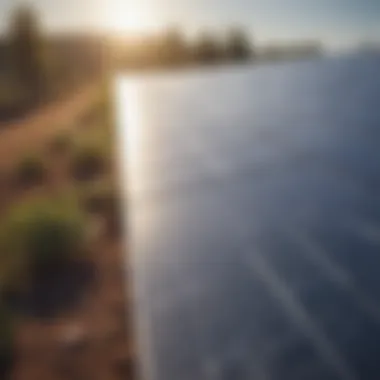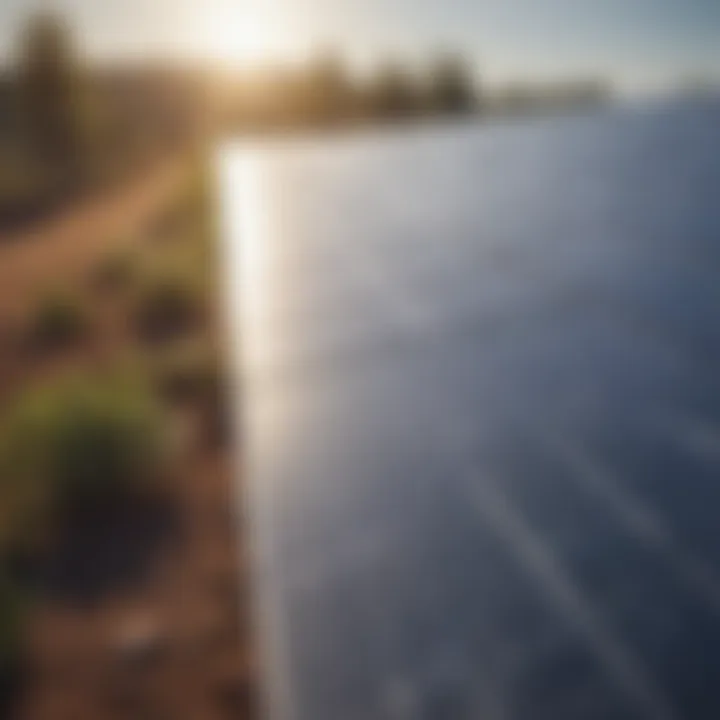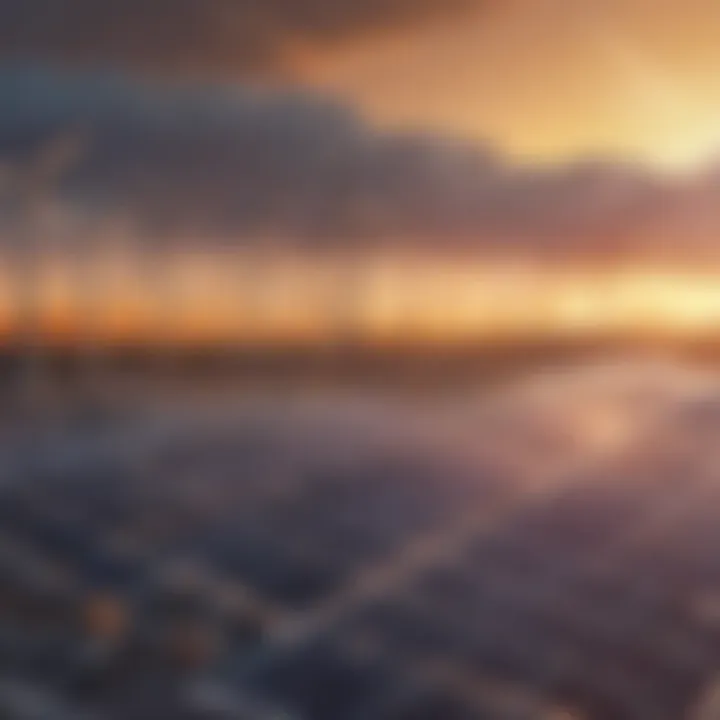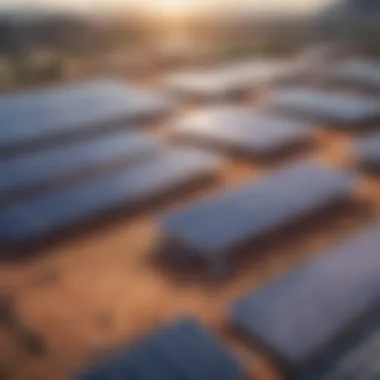Disadvantages of Solar Power: A Detailed Overview


Intro
As the world shifts gears towards renewable energy, solar power often takes center stage. Many view it as the hero in our fight against climate change, but it's crucial to peek beyond the glittering facade. Beneath its sunlit surface lie a range of disadvantages that can complicate its implementation and effectiveness. This deep dive doesn't merely scratch the surface; it probes the shadows of solar technology, shedding light on the noteworthy challenges lurking there. This analysis isn't just for environmental enthusiasts; it speaks to investors, financial advisors, analysts, and students, equipping them with the knowledge needed to make informed decisions in the evolving landscape of renewable energy.
Investment Dictionaries
To navigate the complex world of solar power investment, it's essential to familiarize ourselves with some financial terminologies that are frequently used.
Common Financial Terms
Understanding basic financial terms can empower potential investors and educators alike. Here are some key concepts:
- CapEx (Capital Expenditure): Refers to the initial costs required for purchasing solar panels and related equipment. This upfront investment can be a significant barrier for many.
- ROI (Return on Investment): A measure of the profitability of an investment, particularly relevant for assessing long-term benefits of solar systems against their costs.
- Net Metering: A billing arrangement allowing solar power users to sell excess energy back to the grid, offsetting electricity costs.
Advanced Investment Terminology
Digging deeper into advanced concepts can really drive home the nuances of investing in solar. Consider these terms:
- Levelized Cost of Energy (LCOE): This metric compares the cost of generating electricity from solar panels with traditional energy sources, providing a clearer picture of long-term viability.
- Capacity Factor: A measure comparing actual energy output to the total potential output if the solar panels operated at full capacity constantly. Low capacity factors can signal inconsistent energy generation, which is a critical disadvantage.
- PPA (Power Purchase Agreement): A contract between an energy buyer and a solar provider that outlines the terms of energy sales, often beneficial for organizations with limited upfront capital.
Expert Advice
Tailored Investment Strategies
For those looking to navigate the solar market, being strategic is key. Start by considering the location of potential solar installations. Areas with consistent sunlight can optimize energy generation, but initial costs can still create hurdles.
Investigate government incentives and rebates, which can alleviate some financial burden. Different regions offer various programs, which can significantly influence your investment strategy. Ensure to evaluate the longevity and reliability of your chosen technology.
Risk Management Techniques
Solar investments are not devoid of risks. It's wise to assess:
- Market volatility: Understand how fluctuating energy prices can impact your investment's value.
- Technology obsolescence: The solar field evolves quickly; check if your invested technology may become outdated.
- Regulatory changes: Keep an eye on laws and policies that may affect solar energy implementations.
"Investing in solar demands a comprehensive understanding of its broader ecosystem. From costs to technological advancements, knowledge is your best ally."
Investors and stakeholders need to weigh these factors diligently, remembering that while solar power shines bright on many fronts, it also casts shadows that deserve attention.
Prolusion to Solar Power
Solar power has emerged as a buzzword in discussions about renewable energy, but understanding its implications goes beyond just the glowing reports of efficiency and sustainability. This section lays the groundwork, examining what solar power is and why it merits a thoughtful approach, particularly considering its limitations. In a world increasingly aware of climate change and carbon footprints, investors and policy makers are drawn to solar energy as a beacon of hope. Yet, without a keen analysis of its drawbacks, they may find themselves caught between promising statistics and harsh realities.
Overview of Solar Energy
Solar energy harnesses the radiation from the sun through various technologies, primarily photovoltaic cells and solar thermal systems. The promise of generating clean, renewable energy has contributed to solar's popularity but understanding how it works reveals much about its broader impacts. While cleaner than fossil fuels, the life cycle of solar panels—from manufacturing to installation and eventual disposal—raises questions of environmental sustainability.
For instance, the extraction processes for materials like silicon and rare earth elements can be intensive and environmentally damaging. Additionally, although solar panels can reduce greenhouse gas emissions, the indiscriminate mining practices and industrial processes involved in their production can offset some of the benefits touted by advocates.
- Key points to consider:
- Manufacturing solar panels involves resource extraction that can be harmful to ecosystems.
- The shift to solar energy must balance efficiency with ecological impact.
The Rise of Solar Technology
Technological advancements have propelled solar energy to the forefront of renewable resources. Early solar panels were cumbersome and inefficient, but today's models are sleeker, more effective, and more versatile. Innovations such as bifacial panels enhance efficiency, allowing energy capture from both sides.
However, despite these advancements, the solar industry faces persistent challenges such as efficiency limits. Many of the most effective panels still only convert around 20-25% of sunlight into electricity. While that's a step forward compared to earlier iterations, the expectation for continual improvements can sometimes overshadow the technical barriers that still exist.
Moreover, as technology advances, so does the market. This surge has nurtured a competitive landscape leading to fluctuating prices and quality variations among manufacturers, making the decision process tricky for investors. A wise strategy would be to keep an eye on brands that not only lead in efficiency but also adhere to eco-friendly manufacturing processes, as these factors will influence long-term viability and sustainability in this booming industry.
"The potential of solar energy is immense, but achieving that potential lies in addressing both the current limitations and the environmental costs entwined with technology advancement."
In summary, while the landscape of solar technology is bright, stakeholders must navigate the terrain carefully, assessing both the advantages and caveats to make educated choices. Identifying these aspects fosters a more informed dialogue regarding solar power's role in our energy future.
Financial Implications of Solar Energy
Navigating the financial components of solar energy is crucial to understanding its overall viability and sustainability within the broader energy spectrum. This section delves into the financial implications of solar energy, shedding light on the high initial costs involved and the ongoing challenges related to return on investment. Each aspect affects not only potential investors but also policymakers and consumers who are considering the long-term impact of these renewable technologies.
High Initial Costs
One of the more significant barriers to entering the world of solar energy is, without a doubt, the high initial costs involved in installation. Solar panels do not come cheap; the costs associated with purchasing and installing a complete solar energy system can be daunting, often reaching thousands of dollars even before maintenance and other hidden costs are added into the mix.
Cost of Installation
The cost of installation represents a critical hurdle for many homeowners and businesses alike. This expense usually includes labor, permits, wiring, and of course, the solar panels themselves. The average installation price can vary widely based on location, system size, and surrounding regulations. Such costs can deter prospective buyers from making the leap into solar energy, as they often find themselves weighing these financial burdens against immediate energy savings.
A key characteristic of this cost is the dependence on both local and regional pricing, as energy rates fluctuate. Those in areas with higher energy prices may find the initial outlay more acceptable, as they can see the long-term savings more quickly. However, this variability makes solar installation a mixed bag—some may find it a beneficial choice, while others may see it as a major financial misstep.
The unique feature of installation costs is that they can sometimes be mitigated by various incentives, such as tax credits or rebates, but they still remain a significant deterrent in many cases.
Financing Options
When it comes to financing options, there are several routes one might consider. This realm includes everything from loans to leasing options. These choices play a vital role in how accessible solar energy becomes for an average homeowner or business owner.
Key characteristics of financing options include their flexibility and variety. For instance, some programs allow users to lease the equipment rather than buy it outright, thereby removing the hefty upfront investment. This is often a popular choice for those wary of tying up their capital in a long-term investment that may take years to yield returns.
However, there's a distinct unique feature to these financing methods: They can create complex relationships between the third-party providers and system owners. While leasing can seem appealing at first, users may discover they don't own the system, thereby limiting their long-term benefits.
Return on Investment Challenges
While the investment in solar energy systems appears attractive on paper, the reality of returns suggests otherwise. Understanding the dynamics of ROI is crucial for potential investors and users alike.
Break-even Analysis
At the heart of evaluating investment in solar energy systems lies break-even analysis. What does it mean for an investor when calculating the time it takes for the cost of the system to equal the benefits it provides? Typically, this can take five to seven years, depending on energy consumption and regional utility prices.
A beneficial characteristic of conducting a break-even analysis is that it encourages critical thinking about how energy consumption correlates to solar system efficiency. However, the inherent complexity of these calculations often leaves investors with more questions than answers.


Unique features like variable energy prices and system degradation over time can impact financial outcomes significantly, making the anticipated savings less predictable than first assumed.
Long Payback Periods
Compounding the challenges is the reality of long payback periods associated with solar system investments. Payback periods can, in some cases, extend beyond a decade, depending on installation costs, energy efficiency, and prevailing energy prices.
With these lengthy timelines, one must seriously consider whether the investment is worthwhile, especially when technology evolves rapidly. Indeed, once the market is saturated, homeowners might find their systems losing value over time. This uncertainty is a key characteristic that enforces skepticism around solar energy.
Ultimately, while some may argue that these long payback periods hinder growth, others maintain that these investments foster sustainability. Special attention must be given to the fact that potential savings typically come long after the initial investments.
"Investing in solar is not just a monetary choice, it's a lifestyle commitment that requires forward-thinking and patience."
These financial implications pose crucial considerations. Investors, financial advisors, analysts, and students must understand these dynamics to make informed decisions when it comes to solar energy.
Energy Generation Issues
The effectiveness of solar power hinges on its ability to generate consistent energy. In this section, we will uncover some challenges associated with such generation, which can limit its appeal for potential investors and consumers alike. These issues are not trivial; they can significantly impact an installation's overall performance and reliability. Let's delve into the nuances of these challenges, focusing on their implications for solar energy's reputation and future.
Intermittent Energy Supply
Dependence on Weather
When it comes to solar power, the weather plays a crucial role in how efficient systems can be. Solar panels thrive under clear skies, soaking in sunlight; however, cloudy days or heavy rain can create significant dips in energy production. This reliance on prevailing weather conditions can be a tough pill to swallow for some. Such typeof variability makes solar power less predictable compared to other energy sources, like fossil fuels, which can provide a steady supply regardless of natural conditions.
To add to the complexity, seasons affect sunlight availability as well. During summer months, days are longer, allowing solar systems to harness more energy. But come winter, the sun takes a vacation, leading to potential shortfalls in energy generation. This intermittent energy supply is one of the key characteristics that leads to skepticism about solar power’s dependability as a primary energy source. While solar has its benefits, the fluctuations can be worrying for those looking to invest heavily into this technology.
"The sun doesn’t shine all the time, and that unpredictability can be a game-changer for energy operations."
Night-time Energy Generation
Another critical aspect to consider is that solar panels generate energy exclusively during daylight hours. What happens after the sun sets? This restriction on energy generation at night poses challenges, especially for those relying solely on solar for their nighttime power needs. In the absence of effective energy storage solutions, the only viable option left for consumers is to remain connected to the grid—resulting in a potential reliance on traditional energy sources.
Investors might find it tough to ignore the reality that solar installations cannot directly provide energy at night, which can complicate their financial models. While some solutions exist, like specialized systems designed to store energy for use after dusk, these often come with added costs and complications. The unique feature of relying on stored energy can bring anxiety over its efficiency, leading to questions about the viability of solar as a comprehensive energy solution.
Storage Limitations
Battery Efficiency
Battery efficiency is at the heart of solar energy storage. The ability to store generated energy for later use ties directly into the fundamental advantage of solar technology—being able to harness the sun’s power when it shines the brightest. However, current battery systems, which include lithium-ion options, face challenges in terms of capacity and longevity. While these systems can store energy for use outside of daylight hours, their efficiency often leaves much to be desired, leading to losses during the charge and discharge cycles.
For many investors, this poses serious questions. If the energy that was supposed to be stored efficiently dissipates, does it negate the benefits of investing in solar installations? The accuracy of forecasting energy availability takes a hit due to these efficiency constraints.
Current Storage Technologies
Looking at the current landscape of energy storage technologies illuminates the persistent issues in the sector. While battery storage options are growing, options remain limited. Lead-acid and lithium-ion batteries dominate the market, but neither can completely erase the inefficiencies present. For instance, lithium-ion batteries may be effective but often require significant upfront investment, hence limiting access to many potential users.
Exploring newer technologies like flow batteries or supercapacitors can show promise, yet these are still in developmental phases and have their own issues, be it scalability or cost. Navigating through various current storage technologies can feel like searching for a needle in a haystack, making it evident how these storage challenges intertwine with broader considerations about solar energy viability.
In summary, understanding the energy generation issues associated with solar power sheds light on the significant challenges Washington investors face in making informed decisions about their potential involvement in solar technology. Efficiency and dependability remain hurdles that need addressing to build broader acceptance and reliability in this sector.
Environmental Considerations
In discussions about renewable energy, the term "environmental considerations" is often thrown around like day-old bread. But peeling back the layers reveals that it encompasses critical elements that cannot be overlooked when analyzing solar power. At first glance, solar energy appears to be a clean solution, but it invites its own set of environmental dilemmas, especially when we dive into the manufacturing processes and land use associated with solar technologies. This section aims to shine a light on these concerns, presenting a more nuanced view of solar energy's environmental footprint.
Impact of Manufacturing
Resource Extraction
When it comes to solar panels, the crucial role of resource extraction is undeniable. To kick off, you can't make solar cells without raw materials like silicon, silver, and copper. Mining for these materials raises some alarm bells regarding the environmental impact. For instance, extracting silicon requires significant energy, often derived from fossil fuels. It's a paradox: while solar strives to reduce carbon footprints, its manufacturing can end up being pretty resource-intensive.
The key characteristic here is that resource extraction can lead to extensive habitat destruction. Mining activities disrupt ecosystems, putting species at risk and causing soil erosion. Furthermore, certain materials, like cobalt used in some batteries, may come from regions with unethical mining practices, adding another moral layer to the environmental debate in solar energy. Thus, while the unique feature of leveraging natural resources is advantageous for manufacturing solar panels, the disadvantages come from the ecological and ethical repercussions of how these materials are sourced.
Pollution from Production
Now, let’s tackle pollution from production. During the manufacturing of solar panels, gases and chemical by-products are released, which aren't exactly friendly to the environment. For instance, the production process can emit volatile organic compounds (VOCs) and particulate matter, contributing to air pollution. While the final product aims to generate green energy, the path it takes to get there often flouts the very essence of sustainability.
The key feature of this aspect is that pollution does not just stop at production. It can significantly affect surrounding communities, contributing to health problems and degrading air quality. This pollution issue underscores why understanding the advantages and disadvantages of solar panel production is essential; one must weigh the immediate gains in renewable energy against the longer-term impacts on health and environment.
Land Use Concerns
Displacement of Ecosystems
When solar farms are built on large plots of land, there's a risk of displacement of ecosystems. This is no small potatoes. Large solar installations can obliterate natural habitats, leading to loss of biodiversity. The critical balance that ecosystems maintain is compromised, as flora and fauna find themselves pushed out of their homes.
A notable point is that when considering land use, it’s not just about what’s built; it’s about what’s lost. The key characteristic of land displacement is the irreversible impact on local wildlife. Key species can face extinction if their habitats are destroyed for solar farm expansion. Thus, while solar technology may present a beneficial alternative to fossil fuels, the unique feature of land consumption raises questions about its overall sustainability. It's all tied together in a tight knot of advantages and drawbacks.
Agricultural Land Conversion
Finally, we conclude this segment by examining agricultural land conversion. The push for solar energy has sometimes led to a conversion of farmland into solar farms, which raises eyebrows among food security advocates. The key characteristic of this issue is its impact on local food production. In regions where arable land is already at a premium, sacrificing such land for solar energy can exacerbate food scarcity.
Importantly, while solar installations can be designed to co-exist with agricultural practices (like agrivoltaics), the unique feature here often goes teetering on the edge—food versus energy. This tension marks a significant concern as we weigh the advantages of renewable energy against the fundamental need for food production.
"Solar power is often dubbed as the future of energy, but it must tread carefully, lest it sacrifices the very land that feeds us in its pursuit of sustainable solutions."
In summation, the environmental considerations surrounding solar energy are complex and layered. Manufacturing challenges reveal the intricacies of resource extraction and pollution, while land-use issues raise critical questions about biodiversity and food security. As we strive for cleaner energy, understanding these trade-offs becomes essential in furthering effective discussions and informed decision-making.
Technological Limitations
The advent of solar energy has ushered in a new way to tap into the vast resources of nature. However, it is not all sunshine and rainbows. Technological limitations can hinder its full potential, making it crucial to address these issues. These limitations can significantly impact the effectiveness and viability of solar energy as a primary energy source. From efficiency constraints to concerns regarding durability and longevity, these factors play a fundamental role in the energy landscape.
Efficiency Constraints
Conversion Rates
Conversion rates are a pivotal aspect of how effectively solar panels convert sunlight into usable electricity. In general, the conversion rates of most commercially available solar panels hover around 15% to 20%. This means that for every 100 units of sunlight hitting the panel, only 15 to 20 units are transformed into electricity. This inefficiency can limit the amount of energy harnessed from a given area, which is a critical consideration for developers and investors.
To put it simplistically, if the conversion rate is low, it translates directly into needing more panels or larger installations to generate sufficient power. While innovation and investment have propelled conversion efficiencies higher in some premium models, the widespread adoption of these technologies remains a challenge due to cost barriers.
Advancements in Technology
Emerging technologies in solar energy are continuously improving the landscape. From bifacial solar panels that absorb light from both sides to perovskite cells with significantly high conversion efficiencies, there is much potential for improvement. These advancements can lead to better energy capture and utilization in both residential and commercial settings. Moreover, many of these new technologies are designed to be more flexible, lightweight, and aesthetically pleasing, which can enhance their market appeal. Yet, while these developments are promising, they also necessitate ongoing research and investment, which may not always be available or prioritized. In addition, the vast differences in material properties might make some technologies less feasible or cost-effective for certain geographical or regulatory environments.


Durability and Lifespan
Component Lifespan
The lifespan of solar components is another crucial factor that influences decision-making in investments and policy. Typically, solar panels are expected to last between 25 to 30 years. However, this does not account for degradation rates, which can affect the efficiency of panels over time. For example, most panels degrade at an average rate of about 0.5% to 1% per year. Therefore, a panel that starts at 20% efficiency might only provide around 16% efficiency at the end of its expected lifespan. Investors need to be cognizant of these figures for long-term financial planning and understanding the effective lifespan of a solar installation.
Maintenance Requirements
While solar energy is often touted as a low-maintenance option, regular upkeep is required to ensure optimal operation. This might include cleaning the panels to remove dust, dirt, and debris that can obstruct sunlight. In addition, components like inverters have a limited lifespan and require periodic replacement. The maintenance costs can gradually add up, impacting overall financial returns. Many current systems also rely on technologies that might not be available everywhere, leading to potential delays in repairs. Being informed about these aspects is vital for anyone thinking about entering the solar market, as they dictate how well the system will perform in the long run.
"Technological limitations pose both challenges and opportunities in solar power. Unraveling these factors can lead to informed decisions that drive successful renewable energy implementation."
With a thorough understanding of these technological limitations in mind, stakeholders are better equipped to navigate the complex landscape of solar energy. Each factor amplifies the need for careful consideration of how best to implement these technologies in a manner that maximizes benefits while minimizing downsides.
Regulatory and Policy Challenges
Navigating the landscape of solar energy is akin to walking through a minefield, filled with regulatory frameworks and policy stipulations that can either propel or impede progress. Understanding such challenges is crucial for investors and stakeholders keen on capitalizing on the solar revolution. These challenges can significantly influence the efficiency of solar energy implementation, shaping the overall market accessibility and viability.
Policy Stability
Incentive Fluctuations
One of the most pressing difficulties in solar energy adoption revolves around incentive fluctuations. These incentives, often in the form of tax credits or rebates, can sway dramatically based on political winds. For instance, when lawmakers change, so can the financial incentives offered for solar technologies.
The key characteristic of these fluctuations is their capacity to create uncertainty. It leaves potential investors scratching their heads, wondering whether the foothold they are looking to gain today could vanish tomorrow.
This volatility lends itself to a risky environment for solar investments. If a policy that encourages solar installations suddenly dissolves, the anticipated return on investment might take a nosedive. While short-term gains might be visible, long-term planning could quickly unravel, leading to market skepticism.
The unique feature of incentive fluctuations lies in their unpredictability. Investors may find that navigating these changes requires constant diligence and reevaluation. Additionally, the advantages of well-funded incentives can motivate rapid market expansions, yet if those incentives fluctuate widely, the adverse effects can roll back hard-earned advancements in the solar sphere.
Tariff Changes
Tariff changes mirror the unpredictable nature of incentive structures. These adjustments can directly impact the price of solar equipment, which is often imported. A surge in tariffs can cause the cost of solar panels to leap overnight, making solar installations less attractive.
The major characteristic of tariff changes focuses on their immediacy and impact. Such adjustments can radically change project viability in an instant. Investors often assess their proposals not just on initial costs, but also on future projections for maintenance and growth. This aspect can prove especially challenging amid shifting tariff rates.
A unique feature of these tariff changes is their global implication. Changes in tariffs can ripple through international trade, creating a domino effect where manufacturers in one country may scale back production due to diminished demand in another. This intricate dance results in uncertainties within the global market.
Ultimately, while tariff changes can sometimes favor domestic producers, they can also impede broader access to cost-effective solar technology—a clear disadvantage that weighs down on the overall health of solar energy investment.
Regulatory Hurdles
Regulatory hurdles can act as barriers to entry that discourage innovative solar projects from seeing the light of day. Compliance with various local, state, and federal regulations can create an exhaustive and time-consuming approval process.
Permitting Delays
Permitting delays exemplify the sluggish nature of regulatory processes. Each jurisdiction may impose its own set of requirements, leading to a confusing maze for potential solar developers. What could take weeks in one area may stretch into months or even years in another.
The distinguishing aspect of permitting delays is their impact on project timelines. Solar developers might have secured financing but find themselves stalled at the starting gate due to prolonged permitting processes. These hindrances not only eat into profitability but can also scuttle well-laid plans for sustainable energy production.
This unpredictability can deter new entrants into the market, stifling innovation and growth in the solar sector. Stakeholders may hesitate to take on new projects if they feel that regulatory pathways will delay their operational timelines significantly.
Compliance Requirements
Furthermore, compliance requirements represent another layer of complexity that solar proponents must navigate. The legislation surrounding renewable energy is continually evolving, often requiring developers to stay attuned to shifting compliance criteria. This ongoing necessity to adapt brings an inherent risk to investment stability.
The key attribute of compliance requirements emphasizes their complexity. Each set of regulations can encapsulate a multitude of detailed guidelines, making adherence a project in itself. Owners and directors must ensure that everything from installations to operational day-to-day functions aligns with the local, state, and federal standards.
Unique features of compliance include ongoing obligations, which can extend long after initial project realization. Compliance checks, environmental assessments, and regular reporting can lead to unforeseen expenses and bureaucratic entanglements.
While such regulations aim to keep solar growth sustainable, they also serve as notable roadblocks that discourage potential investors, shifting their focus away from the solar sector and hindering the advancement of cleaner energy solutions.
Understanding these regulatory and policy challenges is essential for fully grasping the limitations facing solar power implementation. Investors must consider not just the immediate economic factors but also the broader environmental and regulatory consequences as they navigate this scenario.
Social Considerations
The social factors surrounding solar power are critical for understanding its broader implications in society. While solar power is often pitched as a progressive solution to energy needs, its integration into existing social structures raises significant questions. The public's viewpoint, job market dynamics, and cultural implications shape how this renewable energy is perceived and implemented.
Public Perception
Skepticism Around Renewable Energy
One major aspect of public perception is the skepticism around renewable energy. This skepticism can stem from various factors including misinformation or earlier negative experiences with technology. Many folks see solar energy as unpredictable and some worry about its long-term viability. The characteristic of skepticism here can be attributed to a historical view of renewable sources being unreliable, particularly in regions where sunlight is intermittent. This creates hesitance among potential adopters and investors, which can influence market conditions and policy decisions.
Those who advocate for solar power must bridge this gap by emphasizing the advancements in technology that enhance reliability. For instance, today’s solar panels are more efficient and durable than those from a decade ago. However, skepticism is a double-edged sword; while it can spur innovation and lead to better products, it can also hinder investment in solar infrastructure.
"Skepticism, while often seen as an obstacle, can push industries to prove their worth and reliability."
Cultural Impacts
Cultural impacts play a significant role in how solar power is embraced by communities. In many areas, renewable energy is tied into the identity and ideology of the populace. Some communities genuinely view solar energy as a pathway to sustainability and independence, while others may not prioritize it due to differing cultural values.
The diversity in cultural reception can affect investments in solar infrastructure. For example, communities that value traditional energy sources may resist the transition to solar, impacting its market penetration. Additionally, embracing solar energy can bring awareness to wider environmental issues, adding layers of cultural significance. Its uniqueness in fostering community-driven initiatives can also lead to a collective movement towards a greener future.
Job Market Impacts
Job Creation vs. Job Loss
The job market impacts related to solar energy are multifaceted. The introduction of solar power generates jobs, from manufacturing to installation. However, it's not all roses. There is an ongoing debate about the balance between job creation in solar industries and job loss in fossil fuel sectors. This can create friction, especially in communities heavily reliant on traditional energy jobs.
While the renewable sector is seen as a growing field, the transition can lead to displacement of workers. Advocates for solar cite the potential for net job creation, but the challenge remains to train and transition those losing jobs in fossil fuel industries. Investing in reskilling initiatives can be a pathway to address these concerns, showcasing a unique feature of the transition—though it comes with its own set of disadvantages, particularly in terms of time and funding.
Market Shifts
Market shifts related to solar energy are now a hot topic. The rise of solar technology is shifting the energy landscape, leading to a demand for new skill sets and operational models. As more companies pivot towards solar, traditional energy industries are left grappling with changes.
The challenge here is striking a balance between the growth of renewable sectors and the stability of existing job markets. Such transitions can lead to disruptions. Those involved in utilities or fossil fuel industries may face a significant adjustment period. However, the upward trend of solar's adoption gives hope that enough jobs will proliferate in emerging markets to offset losses, even if there are temporary uncertainties in the job market.
In summary, the social considerations surrounding solar power are vital for grasping its full implications. From the cultural aspects to job market impacts, understanding these elements can aid stakeholders in navigating the complex terrain of solar energy adoption. By fostering public trust and addressing job concerns, society can work toward a smoother transition into a more sustainable future.


Comparison with Other Energy Sources
The exploration of how solar power stacks up against traditional and alternative forms of energy is a critical part of understanding its potential drawbacks. By examining solar alongside fossil fuels and other renewables, we can paint a fuller picture of its viability, both financially and environmentally.
Fossil Fuels vs. Solar
Cost Comparisons
Cost comparisons between fossil fuels and solar energy lay bare one of the key debates in the renewable space. While solar power installation can initially resemble a steep hill to climb, it often ages like fine wine, improving its value over time. Solar panels, primarily once seen as a luxury, are now accessible—and when numbers crunch come into play, their long-term savings shine bright.
A common misconception is that fossil fuels are simply cheaper to maintain. Yet, as extraction costs rise and supply chains feel the strain, solar begins to look better on a balance sheet. Powering a home through traditional means—coal, oil, or natural gas—harbors costs that fluctuate with market volatility. In contrast, solar tends to come with more predictable financials.
- Key characteristic: Solar's potential for low operating costs once installed is remarkable.
- Advantages:
- Fixed energy costs reduce long-term financial exposure.
- Incentives might make initial costs more palatable.
However, it is paramount to recognize the struggle of sky-high upfront costs in solar adoption. Investors have to navigate through various financing options to make solar a reality.
Environmental Concerns
The environmental concerns surrounding fossil fuels are as apparent as a rain cloud on a sunny day. The emissions from coal plants, for instance, contribute significantly to air pollution, which is detrimental to public health and contributes to climate change. Solar energy promises a cleaner alternative, yet its production has its own set of environmental implications.
- Key characteristic:
The reduction of emissions serves as a showcase for solar's environmental advantages. - Advantages/Disadvantages:
- Solar panels contribute minimal emissions in operational phases, making them a cleaner option.
- However, manufacturing solar panels requires energy and materials that can impact aquatic systems and degrade ecosystems.
In understanding these comparisons, it becomes evident that while solar energy offers promising prospects, it must also contend with a reality woven from both its strong and weak threads.
Alternative Renewables
Comparing solar energy to other renewable sources exposes the kaleidoscope of options available, each with distinct merits and drawbacks.
Wind Energy
Wind energy stands tall as a competitor in the renewable realm. Reliability often depends on geographical conditions, but regions blessed with consistent winds can see remarkable efficiency from wind farms.
- Key characteristic:
Wind energy's low operational costs after installation are a significant draw. - Advantages:
- Wind farms do not require the expansive land use of solar arrays, leading to less disruption of ecosystems.
- They can produce energy at any time, day or night, provided the wind is blowing.
However, wind energy also faces its hurdles—periods of low wind create power challenges, and local wildlife concerns cannot go unnoticed.
Hydropower
Hydropower represents another strong player in the renewable energy game. This method captures the energy of flowing water, often providing a constant and reliable energy source.
- Key characteristic:
Hydropower demonstrates efficient energy production that often outpaces solar and wind. - Advantages/Disadvantages:
- It's generally able to produce large amounts of energy consistently.
- On the flip side, hydropower projects can disrupt local ecosystems significantly, altering waterways and impacting fish populations.
In the evaluation, while solar energy presents its fair share of hurdles, a side-by-side analysis against other energy forms enriches our understanding of its advantages and constraints.
Future Outlook for Solar Energy
The future of solar energy is often painted with a brush of optimism, yet it is essential to consider both the promises and challenges associated with it. This section provides a glimpse into what lies ahead for solar energy, emphasizing the transformative technological advancements and potential policy shifts that could shape its landscape. Understanding this future outlook plays a crucial role for investors, financial advisors, analysts, and students, as it informs investment decisions and strategic planning in renewable energy.
Emerging Technologies
Advancements in Solar Cells
As we look ahead, advancements in solar cells stand at the forefront of solar energy's evolution. The focus here lies in improving the efficiency and effectiveness of solar panels. For example, perovskite solar cells, which have gained significant attention debido to their ability to convert sunlight into electricity more efficiently than traditional silicon cells, are contributing to this momentum. One of the key characteristics of these cells is their potential for lower production costs, making solar energy more accessible to a broader audience.
Moreover, the unique feature of perovskite solar cells is their flexibility and lightweight nature. This allows for innovative deployment options, such as integrating solar panels onto buildings or vehicles. The advantages here are clear—higher efficiency could lead to greater energy generation, even in less-than-ideal conditions. However, concerns about the long-term durability and stability of these cells remain, which could pose challenges as they aim for a more extensive market adoption.
Innovative Storage Solutions
Turning the spotlight on innovative storage solutions, battery technology has made substantial leaps forward, reflecting its critical role in the energy landscape. One notable advancement is in lithium-sulfur batteries, which promise to offer higher energy density compared to current lithium-ion technologies. The crucial aspect of these innovative storage solutions is their potential to store more energy, addressing the intermittency issues that plague solar generation.
What sets lithium-sulfur batteries apart is their ability to provide a longer lifespan and improved safety features. This can enhance the overall reliability of solar energy systems. Yet, drawbacks still lurk—manufacturing these batteries can be complex and costly, which may offset some of their benefits in the short term.
Potential Policy Changes
Increased Investment
Increased investment in solar energy is another pillar that can significantly influence the future outlook. Financial backing from both the private and public sectors is essential. The key characteristic of this investment is that it has the potential to catalyze innovation, making it a crucial element of growth. For this article, emphasizing increased investment illustrates how committed funding can pave the way for pioneering technologies and sustainable growth in the solar sector.
The unique feature of this investment landscape is that it draws in diverse stakeholders, from grassroots movements urging for clean energy solutions to multinational corporations looking for greener portfolios. However, potential over-reliance on government incentives and subsidies could lead to market instability if policies shift unexpectedly.
Global Trade Agreements
Lastly, global trade agreements play a significant role in shaping the solar industry's future. As barriers to trade gradually dissolve, the flow of solar technology and materials across borders can streamline production processes and reduce costs. A crucial aspect of these agreements is their potential to foster collaboration, driving innovation through shared knowledge and resources.
The unique benefit here is that nations can work together to address common challenges in solar implementation, such as supply chain constraints or environmental concerns stemming from manufacturing. Conversely, an over-dependence on international supply chains can leave countries vulnerable to global market fluctuations or geopolitical tensions, raising questions about energy independence.
"The future of solar energy not only rests on technological advancements but also on the political will to support sustainable practices globally."
In summary, the outlook for solar energy is a mixed bag of potential and pitfalls. By examining emerging technologies, investment trends, and trade policies, stakeholders can better navigate the challenges and prospects that lie ahead.
Ending
The conclusion of this article serves as a crucial point of reflection regarding the myriad disadvantages linked to solar power. While the promise of solar energy paints a bright picture for a sustainable future, it is imperative to distill the complexities and potential downsides associated with its implementation. The essence of this section is to present a holistic view that encompasses financial implications, production challenges, and societal impacts of solar technology.
Summarizing the Disadvantages
Solar power indeed boasts a range of benefits; however, the disadvantages merit equal attention to ensure any investments made are sound. Notably, the high initial costs associated with installation can be a significant barrier for many potential adopters. The upfront financial burden, coupled with the long payback periods, often leads to skepticism from investors. Furthermore, the intermittent nature of solar energy poses reliability issues, especially when factoring in the unpredictability of weather.
In addition, the environmental impact of solar panel manufacturing is often overlooked. The processes needed to produce solar panels often involve the extraction of rare materials, which in itself can lead to ecological harm. This includes pollution that can arise from production and disposal phases when panels reach the end of their lifespan. Alongside these concerns, the question of land use arises. Solar farms require significant tracts of land, potentially putting agricultural areas or vital ecosystems at risk.
Importance of Informed Decisions
Given the intricacies outlined, the importance of informed decision-making cannot be overstated. Every stakeholder—be they investors, policymakers, or consumers—must weigh the potential benefits against the drawbacks of solar energy adoption. For investors, understanding the nuances can mean the difference between a fruitful venture and a costly misstep.
Informed choices foster responsible investments that not only prioritize financial returns but also account for environmental and social responsibilities. The implications of neglecting these factors can reverberate through communities and ecosystems alike.
Ultimately, the takeaway must be a balanced perspective. Solar power, while bearing inherent disadvantages, is still a vital part of the transition towards renewable energy solutions. However, stakeholders must navigate this landscape with their eyes wide open, acknowledging that the road to a sustainable energy future is paved with complex challenges and opportunities.







